Fix: Outlook Stuck on Processing
If you didn’t believe in corporate carelessness until now, here’s a good example that might change your mind. I’m talking about the head-scratching bug that has plagued every Microsoft Outlook versions from Outlook 2007 to Outlook 2016.

The bug usually manifests itself as follows: you open Outlook and you’re presented with a splash screen that tells you that add-ins are being loaded. After a while, the window says “Processing”, and that’s where it freezes. You can leave it to load for days, it will not get past the initial splash screen.
Some users have managed to get around this issue by closing Outlook from Task Manager and re-opening it again. But this method is only a temporary fix and has been proved to be ineffective for the vast majority of users that are dealing with this issue.
Since it only affects a tiny percent of the huge Outlook user base, Microsoft has not yet released a solid fix that deals with this issue entirely. Luckily, there are a lot of methods that proved to be successful in dealing with this bug. However, you need to prepare yourself for an extensive troubleshooting session.
But before we get to the fixes, let’s go through the most common causes that will cause this bug to appear:
- A license agreement from the last Office update has not been accepted
- Microsoft Office doesn’t have the latest updates
- Glitched Microsoft Office
- Corrupted Outlook profile
- Hardware acceleration causes hanging at the initial splash screen (Outlook 2013)
- Outlook is not configured to run maximized
- Outlook Frame value needs to be deleted from the registry (Outlook 2016)
So does your Outlook hang or freeze at “Processing” when you open it? There are a lot of potential fixes for this issue. Below you have a collection of methods that will help you get rid of the “Processing” error in Outlook.
Note: Keep in mind that some methods are specific to certain Outlook versions, and may not work on yours.
Please follow the guides in order as they are ordered by likelihood of success. Let’s begin.
Method 1: Closing every Outlook dialog box (All Outlook versions)
The more you know about technology, the more susceptible you are to missing out the simplest of things. Dialog boxes are easy to miss but can make your Outlook unusable if you don’t tend to them.
Outlook has the habit of double-checking some of your decisions by making you confirm via a dialog box. As long as you interact with them, you’ll be fine, but if you don’t choose any options from the dialog box, Outlook will block you from doing anything else.
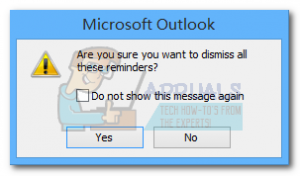
If you force close your Outlook while a dialog box is open, you might glitch the dialog box so that it remains in your taskbar. The next time you try to Open Outlook the dialog box will make the program hand or freeze at the initial splash screen.
A quick way to check for dialog boxes is to press Alt+Tab. This will show you every window and enable you to move freely between them. If you spot a dialog box belonging to Outlook, close it immediately. If not, move over to the next method.
Method 2: Install the latest Microsoft Office updates (All Outlook versions)
Microsoft has released some hotfixes at the end of 2016 that will eliminate the “Processing” error in some instances. However, the hotfix appears to only fix problems related to the license agreement and window size. However, it’s worth updating to the latest version if you haven’t already done it.
Since it will replace some files in your Office folder, there’s a slight chance that it will remove the corrupted file that is causing the issue. Here’s how to update your Office suite to the latest version:
- Open another program from the Office suite like Excel, Word, etc.
- Click on File and select Account. If you don’t see an Account entry, click on Office Account. Once you’re there, click on Account Settings.

- Now click on Update Options (under Product Information) and select Update Options. Begin the update process by clicking on Update Now.
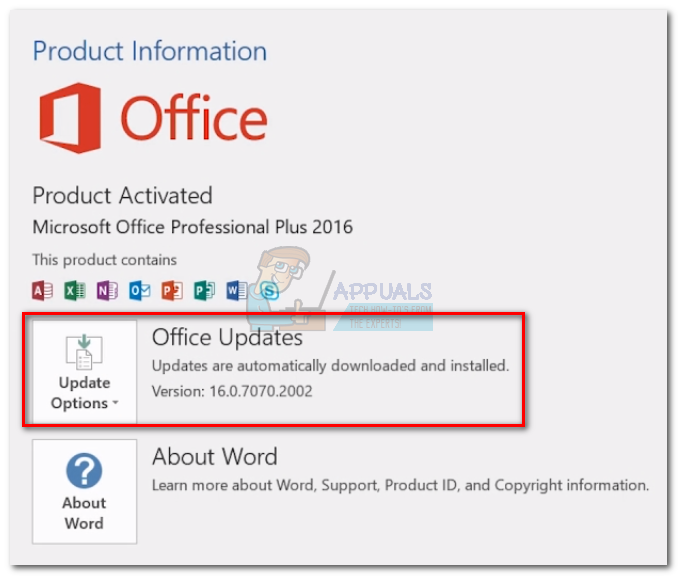 Note: Keep in mind that this will update all your Office suite, not just Outlook. It may take more than 10 minutes.
Note: Keep in mind that this will update all your Office suite, not just Outlook. It may take more than 10 minutes. - Once the update is complete, close the set-up wizard and attempt to start Outlook again. If you’re still getting the “Processing” error, move over to the next method.
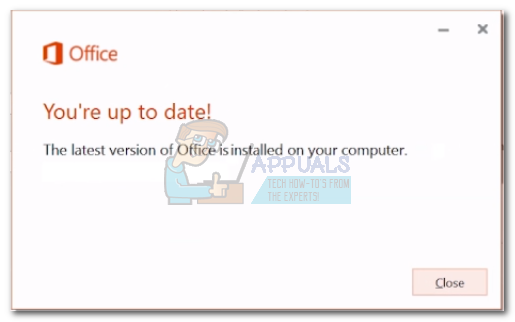
Method 3: Accepting the Licence Agreement from Safe Mode (Outlook 2016, Outlook 2013)
That’s right. A pointless license agreement can get you close to throwing your computer out the window. Apparently, it’s mandatory to Accept every new license agreement that Microsoft throws out at you. If you didn’t agree to it at the first Outlook launch after the update, chances are your Outlook became unusable since then.
The only way to accept the license agreement that has been rendering your Outlook inaccessible is to start it in safe mode. Microsoft has since apologized and admitted that it was an error on their part. The sincere apology won’t restore the functionality of Outlook, but the steps below will:
Note: The following steps might not work for you if you already agreed with the latest license agreement. But since there’s no chance of hurting your device, you can try it and see for yourself.
- Close Outlook completely.
- Now we need to launch Outlook in Safe Mode. The steps are different across different Windows versions:
On Windows 10 – Click on the Search bar and type “Outlook.exe /safe”. Press Enter to launch Outlook in Safe Mode.
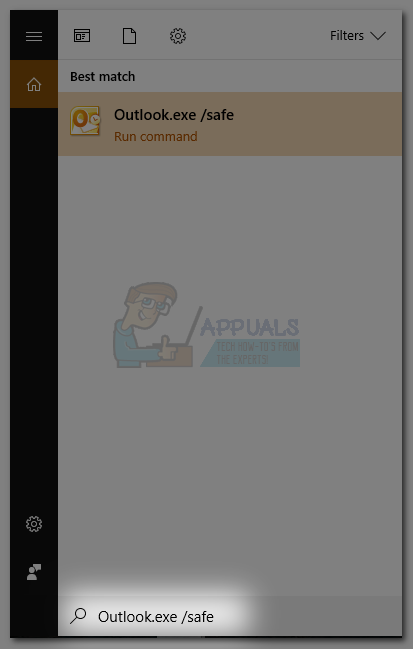
On Windows 8 – Click the Start menu and select Run. Type “Outlook /safe“, and then choose OK to start the program.
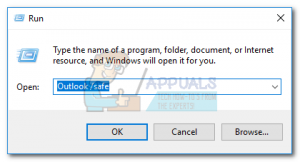
On Windows 10 – Choose Start, and in the Search programs and files box, type “Outlook /safe“, and then press Enter.
- Wait until Outlook starts in Safe Mode. You might be asked to confirm your email profile again. Insert your credential and proceed further.
- If you haven’t agreed on the new Licence Agreement, you will notice an Accept button in the bottom-right corner of the screen. Click on it and wait for Outlook to load.

- If your Outlook manages to load up fully in Safe mode, close it and then open it normally by double-clicking the executable. In the event that these steps didn’t fix your issue, proceed to Method 4.
Method 4: Repairing your Office suite (Outlook 2016, 2013, 2010)
If the Office update didn’t produce any results, let’s try a general repair of your Office programs. The repair tool in Office is specifically designed for instances where some programs from the suite are experiencing hanging, freezing, and non-responsiveness. Before trying one of the manual fixes below, let’s try an automatic repair. Here’s how:
- Close Outlook and every other Office program you might have running.
- Go to Control Panel > Programs and choose Programs and Features.
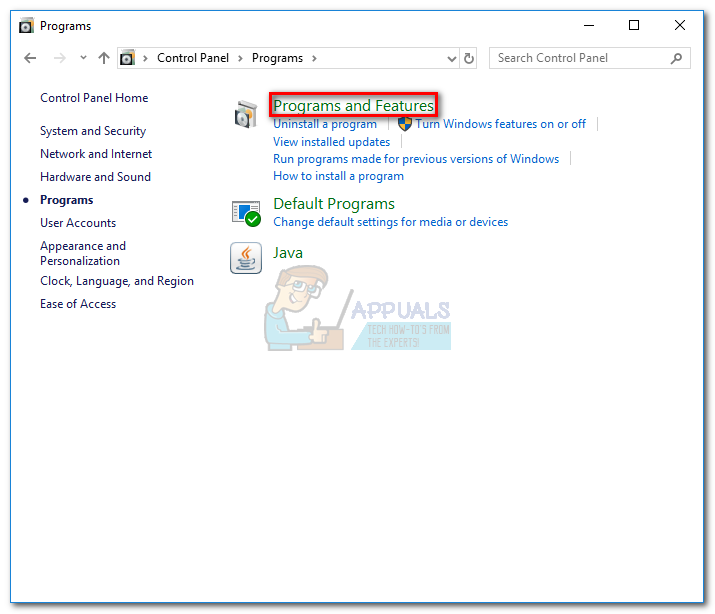
- Now you should see a list with all your installed programs. Scroll down and find your Microsoft Office entry. If you have multiple Office suites, select the one that has been acting up.

- Right-click the Microsoft Office suite that contains the faulty Outlook and choose Change.

- Select the Repair toggle, hit Continue and wait for the process to complete.

- Once the repair is complete, restart your Outlook program and see if the issue repeats.
Method 5: Starting Outlook in Airplane Mode (All Outlook versions)
This is a temporary fix, but it will enable you to open Outlook and load up your emails. The fix involves starting Outlook while there’s no active internet connection. The easiest way to do it is by enabling Airplane Mode. Some users have even reported that it fixed the issue permanently. Here’s what you need to do:
- Close Outlook and associated dialog boxes.
- Click the Network icon in the bottom-right corner of your PC.

- Click on Airplane Mode to activate it.
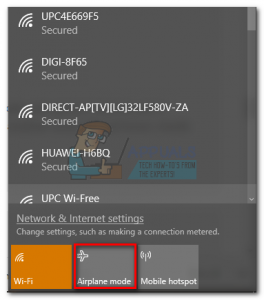
- Start Outlook and see if it loads up. If it gets past the splash screen, click on Airplane mode again to disable it. Your emails, calendars, contacts, and any other data should load up shortly.
Method 6: Forcing Outlook to run maximised (All Outlook versions)
Believe it or not, hanging at the “Processing” stage might, in fact, be caused by Outlook not starting properly in a custom size. As it turns out, forcing it to always run maximized can enable you to go past the splash screen. Here are the steps of manually configuring Outlook to run in Maximised mode:
- Force-close Outlook and any related dialog boxes.
- Right-click on the executable that you use to start Outlook and click on Properties.
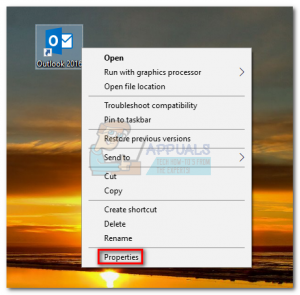
- Click on the Shortcut tab to bring it forward. Then, click the drop-down menu next to Run and click on Maximised. Hit Apply to confirm.
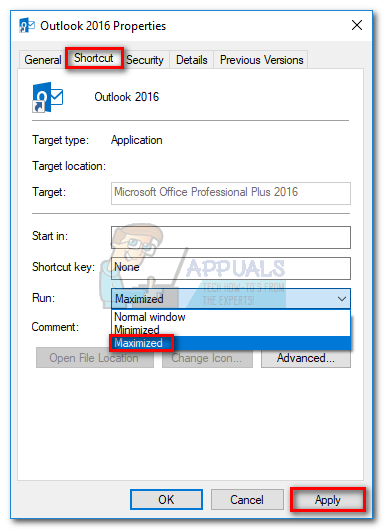
- Open Outlook from the executable you’ve just modified and see if the issue has been eliminated.
Method 7: Running the /resetnavpane command (All Outlook versions)
The navigation pane can be found in the left portion of your Outlook screen. It allows users to move easily between emails, calendars, people, and tasks. But it can also glitch out just as easily and prevent Outlook from starting properly. However, there is a command capable of resetting navigation pane any customisation along with any glitch. Here’s how to use it:
- Close Outlook.
- Press Windows key + R.
- Type “Outlook.exe /resetnavpane” and hit Ok.

Method 8: Repairing Outlook data files (All Outlook Versions)
Every Outlook version will be accompanied by an efficient repair tool called Inbox Repair Tool (ScanPST.exe). If performing a general repair has proved to be ineffective, the issue might originate from your Personal Folders Profile (PST).
If corruption inside your PST file is causing the “Processing” error, scanning your Outlook data files using the Inbox Repair Tool can help you eliminate the issue completely. Here’s what you need to do:
- Close Outlook and any related dialog box.
- Navigate to C:\ Program Files or C:\ Program Files (x86) (depending on the architecture you’re using).
- Seach for SCANPST.exe using the box in the top-right corner.
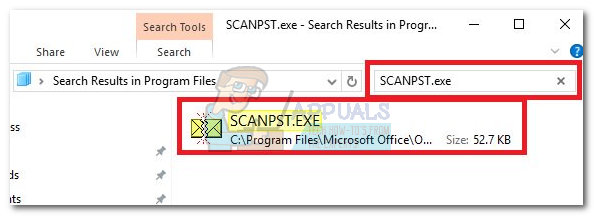 Note: If you don’t manage to find the SCANPST executable by using the search bar, you can navigate to the exact location. Here’s a list of the default locations of the most popular Outlook versions:
Note: If you don’t manage to find the SCANPST executable by using the search bar, you can navigate to the exact location. Here’s a list of the default locations of the most popular Outlook versions:
2016: C:\Program Files (x86)\Microsoft Office\root\Office16
2013: C:\Program Files (x86)\Microsoft Office\Office15
2010: C:\Program Files (x86)\Microsoft Office\Office14
2007: C:\Program Files (x86)\Microsoft Office\Office12 - Double click on SCANPST.exe and click on Browse to set the path of your PST file. The default location of the PST file is in Documents \ Outlook Files. Once you’ve successfully loaded the PST file, hit Start to scan for corruption.

- When the process is complete, you’ll be presented with a dialog box that will show you any errors or inconsistencies found. Make sure you check the box next to “Make backup of scanned file before repairing” and click Repair.

- After the repair is complete, open Outlook again and see if it manages to get past the initial splash screen. If not, proceed to the next method.
Method 9: Creating a new Outlook profile (All Outlook versions)
Before we can completely cross-check a corrupted profile from the culprit list, let’s see if creating new Outlook profile eliminate the “Processing” error. Your Outlook profile holds a variety of settings dictate how your Outlook behaves. Moving your email account to a new profile might enable you to get past the initial splash screen. Here’s what you need to do:
- Make sure Outlook is closed as well as any related dialog box.
- Open Control panel and use the search box in the top-right corner to search for the Mail settings.

- Click on Show Profiles.
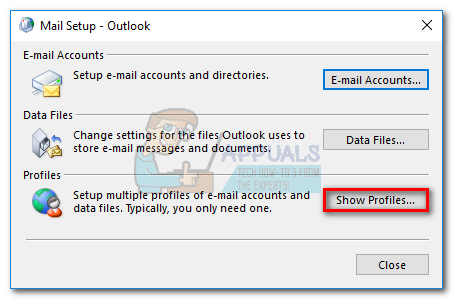
- Create a new profile by clicking on the Add button. Insert a name and hit Ok.
 Note: Avoid deleting the original profile.
Note: Avoid deleting the original profile. - Use Auto Email Account to insert the credentials of your email address and complete the configuring steps.
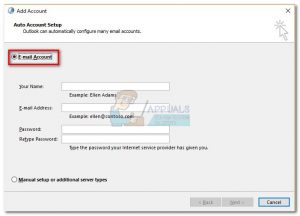
- Once the email is set up with your new Outlook profile, return to the initial Mail window and make sure it’s listed there. If it is, click on Always use this profile and make your new profile as the default choice.
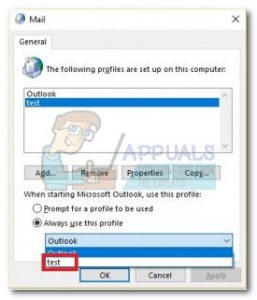
- Start Outlook again and see if it manages to get past the “Processing” screen.
Method 10: Disabling Hardware Acceleration (Outlook 2013, 2016)
If you’ve come this far without a viable fix, there’s a strong chance the issue might originate from your Outlook registry files. There’s a fairly common glitch in both Outlook 2013 and Outlook 2016 related to hardware acceleration that might trigger the “Processing” error or a “Process has been closed” error. Try these steps and see if you get a result:
- Close Outlook along with any associated dialog boxes.
- Press the Windows key + R to pop open a Run command. Type “regedit” and press Enter to open.
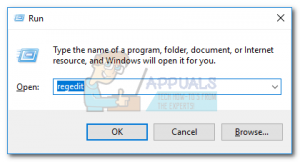
- In the Registry Editor, browse to HKEY_CURRENT_USER \ Software \ Microsoft \ Office \ 15.0 \ Common if you’re using Outlook 2013. For Outlook 2016, go to HKEY_CURRENT_USER \ Software \Microsoft \ Office \ 16.0 \ Common.

- Right-click on the Common folder and navigate to New > Key.

- Name the new folder “Graphics“.
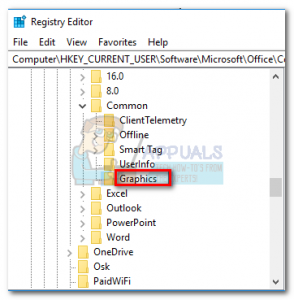
- Select the Graphics folder and right-click on it. In the right panel, go to New and click on DWORD (32-bit).

- Name it DisableHardwareAcceleration and hit Enter to save.
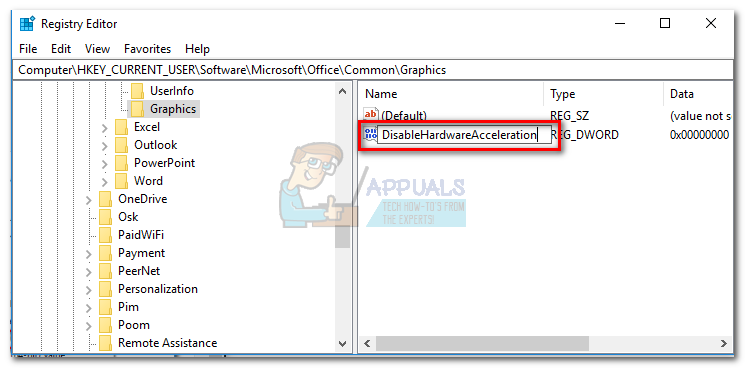
- Double click on DisableHarwareAcceleration, set the Base to Hexadecimal and insert 1 in the box under Value data. Click Ok to save.

- Open Outlook again and see if you managed to get rid of the “Processing” error.
Method 11: Creating a new Outlook data file (All Outlook versions)
Some users have reported that they managed to get rid of the issue by forcing the creation of a new Outlook data file. The following steps will force your Outlook to create and use a new data file. If the data file you’re currently using is corrupted, this will help you get rid of the “Processing” issue. Here’s what you need to do:
- Close Outlook and associated dialogs.
- Open File Explorer and navigate to C:\ Users \ *YourUsername* \ AppData \ Local \ Microsoft \ Outlook.
 Note: If you can’t see the AppData folder, it’s because it’s being hidden by default. To reveal it, expand the View tab in File Explorer and check the box next to Hidden items.
Note: If you can’t see the AppData folder, it’s because it’s being hidden by default. To reveal it, expand the View tab in File Explorer and check the box next to Hidden items.

- Right-click on your Outlook data file and click Rename. Keep the exact same name but add “Backup” at the end of it.

- Now that your data file is identified as a backup, Outlook will automatically create a new one. Start Outlook again and see if it manages to launch without hanging at the “Processing” screen.
Method 12: Deleting the Outlook Frame value from the Registry (Outlook 2016)
If you’ve come this far without results, there’s one more thing you can try before surrendering your computer to a Microsoft technician. However, this will only work on Outlook 2016. It has been reported that deleting the Frame value using the Registry Editor. Here’s what you need to do:
- Exit Outlook 2016 and close any associated dialog boxes.
- Press the Windows key + R to pop open a Run command. Type “regedit” and press Enter to open.

- In Registry Editor, navigate to HKEY_CURRENT_USER \ SOFTWARE \ Microsoft \ Office \ 16.0 \ Outlook \ Office Explorer

- In the details pane, click the Frame value to select it, then acces the Edit menu and click on Delete.

- Click Yes to confirm and exit the Registry Editor.
- Open Outlook again and see if the “Processing” issue is eliminated.
